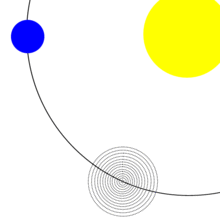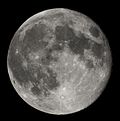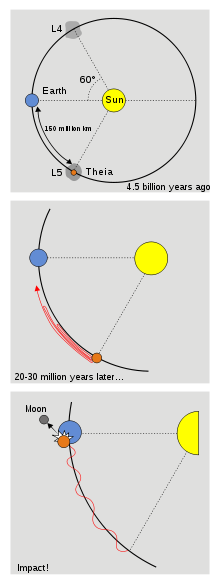- Giant impact hypothesis
-
"Big splash" redirects here. For other uses, see Big Splash (disambiguation).
 Artist's depiction of the giant impact that is hypothesized to have formed the Moon
Artist's depiction of the giant impact that is hypothesized to have formed the Moon
The giant impact hypothesis proposes that the Moon was created out of the debris left over from a collision between the young Earth and a Mars-sized body. The colliding body is sometimes called Theia (or Euryphaessa) for the mythical Greek Titan who was the mother of Selene, the goddess of the moon.[1][2]
The giant impact hypothesis is the current favoured[3] scientific hypothesis for the formation of the Moon. Supporting evidence includes Moon samples which indicate the surface of the Moon was once molten, the Moon's apparently relatively small iron core and a lower density than the Earth, and evidence of similar collisions in other star systems (which result in debris disks). Further, giant collisions are consistent with the leading computer models of the formation of the solar system.
There remain several unanswered questions concerning the best current models of the giant impact hypothesis. The energy of such a giant impact is predicted to heat Earth to produce a global 'ocean' of magma; yet there is no evidence of the resultant planetary differentiation of the heavier material sinking into Earth's mantle. Further, lunar samples do not have expected ratios of oxygen isotopic ratios, volatile elements, iron oxide, or siderophilic elements compared to those of Earth.
Contents
Origins
In 1898, George Darwin made the suggestion that the Earth and Moon had once been one body. Darwin's hypothesis was that a molten Moon had been spun from the Earth because of centrifugal forces, and this became the dominant academic explanation.[4] Using Newtonian mechanics, he calculated that the Moon had actually orbited much closer in the past and was drifting away from the Earth. This drifting was later confirmed by American and Soviet experiments using laser ranging targets placed on the Moon.
However, Darwin's calculations could not resolve the mechanics required to trace the Moon backwards to the surface of the Earth. In 1946, Reginald Aldworth Daly of Harvard University challenged Darwin's explanation, adjusting it to postulate that the creation of the Moon was caused by an impact rather than centrifugal forces.[5] Little attention was paid to Professor Daly's challenge until a conference on satellites in 1974 where it was reintroduced. It was then republished in Icarus in 1975 by Drs. William K. Hartmann and Donald R. Davis. Their models suggested that, at the end of the planet formation period, several satellite-sized bodies had formed that could collide with the planets or be captured. They proposed that one of these objects may have collided with the Earth, ejecting refractory, volatile-poor dust that could coalesce to form the Moon. This collision could help explain the unique geological properties of the Moon.[6]
A similar approach was taken by Alfred G. W. Cameron and William Ward, who suggested that the Moon was formed by the tangential impact of a body the size of Mars. The outer silicates of the colliding body would mostly be vaporized, whereas a metallic core would not. Hence, most of the collisional material sent into orbit would consist of silicates, leaving the coalescing Moon deficient in iron. The more volatile materials that were emitted during the collision would probably escape the Solar System, whereas silicates would tend to coalesce.[7]
Theia
The name of the hypothesized protoplanet is derived from the mythical Greek titan Theia, who gave birth to the Moon goddess Selene. According to the giant impact hypothesis, Theia formed alongside the other planet size bodies in the Solar System about 4.6 Ga (4.6 billion years ago), and was approximately the size of Mars.
One formation theory is that Theia coalesced at the L4 or L5 Lagrangian point relative to Earth (in about the same orbit and about 60° ahead or behind),[3] similar to a trojan asteroid.[8] The stability of Theia's orbit was affected when its growing mass exceeded a threshold of about 10% of the Earth's mass.[3] Gravitational perturbations by planetesimals caused Theia to depart from its stable Lagrangian location, and subsequent interactions with proto-Earth caused the two bodies to collide.[3]
Astronomers think the collision between Earth and Theia happened about 4.53 Ga; about 30-50 million years after the rest of the Solar System formed. However, evidence presented in 2008 suggests that the collision may have occurred later, at about 4.48 Ga.[9]
Impact
In astronomical terms, the impact would have been of moderate velocity. Theia is thought to have struck the Earth at an oblique angle when the latter was nearly fully formed. Computer simulations of this "late-impact" scenario suggest an impact angle of about 45° and an initial impactor velocity below 4 km/s.[10] Theia's iron core sank into the young Earth's core, as most of Theia's mantle and a significant portion of the Earth's mantle and crust were ejected into orbit around the Earth. This material quickly coalesced into the Moon (possibly within less than a month, but in no more than a century). Estimates based on computer simulations of such an event suggest that some two percent of the original mass of Theia ended up as an orbiting ring of debris, and about half of this matter coalesced into the Moon. The Earth would have gained significant amounts of angular momentum and mass from such a collision. Regardless of the rotation and inclination the Earth had before the impact, it would have had a day some five hours long after the impact, and the Earth's equator would have shifted closer to the plane of the Moon's orbit.[citation needed]
It has been suggested that other significant objects may have been created by the impact, which could have remained in orbit between the Earth and Moon, stuck in Lagrangian points. Such objects may have stayed within the Earth-Moon system for up to 100 million years, until the gravitational tugs of other planets destabilized the system enough to free the objects.[11] A study published in 2011 suggested that a subsequent collision between the Moon and one of these smaller bodies caused the notable differences in physical characteristics between the two hemispheres of the Moon.[12] This collision, simulations have supported, would have been at a low enough velocity so as not to form a crater; the material from the smaller body would instead have spread out across the Moon (in what would become its far side), adding a thick layer of highlands crust.[13]
After
In 2011, this theory was extended in an effort to explain the distinct differences found between the lunar near side versus its far side with the publication of computer simulation evidence that suggests that the Theia impact produced not one, but two significantly large ejection bodies which later themselves impacted each other at a low velocity with the smaller body spreading across the surface of the larger to form the highlands that today are on the far side of the Moon.[14] The resulting mass irregularities would subsequently produce a gravity gradient that helped to rotationally lock the Moon so that today only the near side remains visible from Earth.
Evidence
 Animation of Theia possibly forming in Earth's L5 point and then drifting into impact. The animation progresses in one-year steps (before impact) making Earth appear not to move. The view is of the south pole.
Animation of Theia possibly forming in Earth's L5 point and then drifting into impact. The animation progresses in one-year steps (before impact) making Earth appear not to move. The view is of the south pole.
Indirect evidence for this impact scenario comes from rocks collected during the Apollo Moon landings, which show oxygen isotope ratios identical to those of Earth. The highly anorthositic composition of the lunar crust, as well as the existence of KREEP-rich samples, gave rise to the idea that a large portion of the Moon was once molten, and a giant impact scenario could easily have supplied the energy needed to form such a magma ocean. Several lines of evidence show that if the Moon has an iron-rich core, it must be small. In particular, the mean density, moment of inertia, rotational signature, and magnetic induction response all suggest that the radius of the core is less than about 25% the radius of the Moon, in contrast to about 50% for most of the other terrestrial bodies. Impact conditions can be found that give rise to a Moon that formed mostly from the mantles of the Earth and impactor, with the core of the impactor accreting to the Earth, and which satisfy the angular momentum constraints of the Earth-Moon system.[15]
Warm silica-rich dust and abundant SiO gas, products of high velocity (> 10 km/sec) impacts between rocky bodies has been detected around the nearby (29 pc distant) young (~12 My old) Beta Pic Moving Group star HD172555 by the Spitzer Space Telescope.[16] A belt of warm dust in a zone between 0.25AU and 2AU from the young star HD 23514 in the Pleiades cluster appears similar to the predicted results of Theia's collision with the embryonic Earth, and has been interpreted as the result of planet-sized objects colliding with each other.[17] This is similar to another belt of warm dust detected around the star BD +20°307 (HIP 8920, SAO 75016).[18]
Difficulties
This lunar origin hypothesis has some difficulties which have yet to be resolved. These difficulties include:
- The ratios of the Moon's volatile elements are not explained by the giant impact hypothesis. If the giant impact hypothesis is correct, they must be due to some other cause.[19]
- There is no evidence that the Earth ever had a magma ocean (an implied result of the giant impact hypothesis), and it is likely there exists material which has never been processed by a magma ocean.[19]
- The iron oxide (FeO) content (13%) of the Moon, which is intermediate between Mars (18%) and the terrestrial mantle (8%), rules out most of the source of the proto-lunar material from the Earth's mantle.[20]
- If the bulk of the proto-lunar material had come from the impactor, the Moon should be enriched in siderophilic elements, when it is actually deficient in those.[21]
- The presence of volatiles such as water trapped in lunar basalts is more difficult to explain if the impact caused a catastrophic heating event.[22]
- The Moon's oxygen isotopic ratios are essentially identical to those of Earth.[2] Oxygen isotopic ratios, which can be measured very precisely, yield a unique and distinct signature for each solar system body.[23] If Theia had been a separate proto-planet, it would probably have had a different oxygen isotopic signature than Earth, as would the ejected mixed material.[24]
Alternative hypotheses
Other mechanisms which have been suggested at various times for the Moon's origin are that the Moon was spun off from the Earth's molten, blobular surface by centrifugal force,[4] that it was formed elsewhere and later captured by the Earth's gravitational field,[25] or that the Moon formed at the same time and place as the Earth from the same accretion disk. Each of these hypotheses is claimed to lack a mechanism to account for the high angular momentum of the Earth–Moon system.[26]
See also
References
- ^ Halliday, Alex N. (February 28, 2000). "Terrestrial accretion rates and the origin of the Moon". Earth and Planetary Science Letters 176 (1): 17–30. Bibcode 2000E&PSL.176...17H. doi:10.1016/S0012-821X(99)00317-9.
- ^ a b Wiechert, U.; Halliday, A. N.; Lee, D.-C.; Snyder, G. A.; Taylor, L. A.; Rumble, D. (October 2001). "Science". Science (Science (journal)) 294 (12): 345–348. Bibcode 2001Sci...294..345W. doi:10.1126/science.1063037. PMID 11598294. http://www.sciencemag.org/cgi/content/abstract/294/5541/345. Retrieved 2009-07-05.
- ^ a b c d Belbruno, E.; J. Richard Gott III (2005). "Where Did The Moon Come From?". The Astronomical Journal 129 (3): 1724–1745. arXiv:astro-ph/0405372. Bibcode 2005AJ....129.1724B. doi:10.1086/427539.
- ^ a b Binder, A.B. (1974). "On the origin of the Moon by rotational fission". The Moon 11 (2): 53–76. Bibcode 1974Moon...11...53B. doi:10.1007/BF01877794.
- ^ Natland, James H. (2006). "Reginald Aldworth Daly (1871–1957): Eclectic Theoretician of the Earth". GSA Today 16 (2). doi:10.1130/1052-5173(2006)16. http://www.gsajournals.org/perlserv/?request=get-document&doi=10.1130%2F1052-5173(2006)16%5B0024%3ARADETO%5D2.0.CO%3B2.
- ^ Hartmann, W. K.; Davis, D. R. (April 1975). "Satellite-sized planetesimals and lunar origin". Icarus 24 (4): 504–514. Bibcode 1975Icar...24..504H. doi:10.1016/0019-1035(75)90070-6.
- ^ Cameron, A. G. W.; Ward, W. R.; Ward (March 1976). "The Origin of the Moon". Abstracts of the Lunar and Planetary Science Conference 7: 120–122. Bibcode 1976LPI.....7..120C.
- ^ Mackenzie, Dana (2003). The Big Splat, or How The Moon Came To Be. John Wiley & Sons. ISBN 9780471150572.
- ^ Halliday, Alex N (November 28, 2008). "A young Moon-forming giant impact at 70–110 million years accompanied by late-stage mixing, core formation and degassing of the Earth". Philosophical transactions. Series A, Mathematical, physical, and engineering sciences (Philosophical Transactions of the Royal Society) 366 (1883): 4163–4181. Bibcode 2008RSPTA.366.4163H. doi:10.1098/rsta.2008.0209. PMID 18826916. http://rsta.royalsocietypublishing.org/content/366/1883/4163.full.
- ^ Canup, Robin M. (April 2004). "Simulations of a late lunar-forming impact". Icarus 168 (2): 433–456. Bibcode 2004Icar..168..433C. doi:10.1016/j.icarus.2003.09.028.
- ^ Than, Ker (6 May 2008). "Did Earth once have multiple moons?". New Scientist. http://space.newscientist.com/article/dn13836-did-earth-once-have-multiple-moons.html?feedId=online-news_rss20.
- ^ M. Jutzi and E. Asphaug, Forming the lunar farside highlands by accretion of a companion moon, Nature 476, 69–72 (2011)
- ^ "Earth Had Two Moons That Crashed to Form One, Study Suggests". http://news.yahoo.com/earth-had-two-moons-crashed-form-one-study-170201124.html.
- ^ Gary, Stuart (August 4, 2011). "Earth May Have Had Two Moons". DiscoveryNews. http://news.discovery.com/space/two-moons-earth-110804.html. Retrieved 2011-08-04.
- ^ Canup, R.; Asphaug, E. (2001). "Origin of the Moon in a giant impact near the end of the Earth's formation". Nature 412 (6848): 708–712. Bibcode 2001Natur.412..708C. doi:10.1038/35089010. PMID 11507633.
- ^ Lisse, Carey M.; Chen, C. H.; Wyatt, M. C.; Morlok, A.; Song, I.; Bryden, G.; Sheehan, P. (2009). "Abundant Circumstellar Silica Dust and SiO Gas Created by a Giant Hypervelocity Collision in the ~12 Myr HD172555 System". Astrophysical Journal 701 (2): 2019–2032. Bibcode 2009ApJ...701.2019L. doi:10.1088/0004-637X/701/2/2019.
- ^ Rhee, Joseph H.; Song, Inseok; Zuckerman, B. (2007). "Warm dust in the terrestrial planet zone of a sun-like Pleiad: collisions between planetary embryos?". Astrophysical Journal 675 (1): 777–783. arXiv:0711.2111v1. Bibcode 2008ApJ...675..777R. doi:10.1086/524935.
- ^ Song, Inseok; Zuckerman, B.; Weinberger, Alycia J.; Becklin, E. E. (21 July 2005). "Extreme collisions between planetesimals as the origin of warm dust around a Sun-like star". Nature 436 (7049): 363–365. Bibcode 2005Natur.436..363S. doi:10.1038/nature03853. PMID 16034411.
- ^ a b Jones, J. H. (1998). "Tests of the Giant Impact Hypothesis". Lunar and Planetary Science, Origin of the Earth and Moon Conference. http://www.lpi.usra.edu/meetings/origin98/pdf/4045.pdf.
- ^ Taylor, Stuart R. (1997). "The Bulk Composition of the Moon" (PDF). Lunar and Planetary Science. http://www.lpi.usra.edu/meetings/lpsc97/pdf/1070.PDF. Retrieved 2010-03-21.
- ^ Galimov, E. M.; Krivtsov, A. M. (December 2005). "Origin of the Earth-Moon System". Journal of Earth Systems Science 114 (6): 593–600. Bibcode 2005JESS..114..593G. doi:10.1007/BF02715942. [1]
- ^ Saal, Alberto E. et al. (July 10, 2008)). "Volatile content of lunar volcanic glasses and the presence of water in the Moon's interior". Nature 454 (7201): 192–195. Bibcode 2008Natur.454..192S. doi:10.1038/nature07047. PMID 18615079. http://www.nature.com/nature/journal/v454/n7201/abs/nature07047.html. Retrieved 2010-01-30.
- ^ Scott, Edward R. D. (December 3, 2001). "Oxygen Isotopes Give Clues to the Formation of Planets, Moons, and Asteroids". Planetary Science Research Discoveries (PSRD). http://www.psrd.hawaii.edu/Dec01/Oisotopes.html. Retrieved 2010-03-19.
- ^ "Moonwalk". Geological Society of London. September 2009. http://www.geolsoc.org.uk/webdav/site/GSL/shared/pdfs/Geoscientist/Download%20PDF%20copy%20of%20Geoscientist%2019.9%20September%202009.pdf. Retrieved 2010-03-01.
- ^ Mitler, H. E. (1975). "Formation of an iron-poor moon by partial capture, or: Yet another exotic theory of lunar origin". Icarus 24 (2): 256–268. Bibcode 1975Icar...24..256M. doi:10.1016/0019-1035(75)90102-5.
- ^ Stevenson, D. J. (1987). "Origin of the moon–The collision hypothesis". Annual Review of Earth and Planetary Sciences 15 (1): 271–315. Bibcode 1987AREPS..15..271S. doi:10.1146/annurev.ea.15.050187.001415.
Further reading
- Academic articles
- William K. Hartmann and Donald R. Davis, Satellite-sized planetesimals and lunar origin, (International Astronomical Union, Colloquium on Planetary Satellites, Cornell University, Ithaca, N.Y., Aug. 18-21, 1974) Icarus, vol. 24, April 1975, p. 504-515
- Alastair G. W. Cameron and William R. Ward, The Origin of the Moon, Abstracts of the Lunar and Planetary Science Conference, volume 7, page 120, 1976
- Canup, R. M.; Asphaug, E. (Fall Meeting 2001). "An impact origin of the Earth-Moon system". Abstract #U51A-02. American Geophysical Union. http://adsabs.harvard.edu/abs/2001AGUFM.U51A..02C. Retrieved 2007-03-10.
- R. Canup and K. Righter, editors (2000). Origin of the Earth and Moon. University of Arizona Press, Tucson. pp. 555 pp.
- Charles Shearer and 15 coauthors, C. K. (2006). "Thermal and magmatic evolution of the Moon". Reviews in Mineralogy and Geochemistry 60 (1): 365–518. doi:10.2138/rmg.2006.60.4.
- Non-academic books
- Dana Mackenzie, The Big Splat, or How Our Moon Came to Be, 2003, John Wiley & Sons, ISBN 0-471-15057-6.
- G. Jeffrey Taylor (December 31, 1998). "Origin of the Earth and Moon". Planetary Science Research Discoveries. http://www.psrd.hawaii.edu/Dec98/OriginEarthMoon.html.
External links
- Planetary Science Institute: Giant Impact Hypothesis
- Computer modelling of the Moon's creation (Space.com)
- Origin of the Moon by Prof. AGW Cameron
- Klemperer Rosette simulations using Java applets
- SwRI giant impact hypothesis simulation (.wmv and .mov)
- Origin of the Moon - computer model of accretion
- Moon Archive - Including articles about the giant impact hypothesis
- Planet Smash-Up Sends Vaporized Rock, Hot Lava Flying (2009-08-10 JPL News)
- How common are Earth-Moon planetary systems? (arXiv:1105.4616: 23 May 2011)
The Moon Physical features 
Orbit Lunar surface - Selenography
- Near side
- Far side
- Lunar mare
- (List)
- Craters
- (List)
- Mountains
- Valleys
- South Pole – Aitken basin
- Shackleton crater
- Water
- Soil
- Peak of eternal light
- Space weathering
- Transient lunar phenomenon
Lunar science - Geology
- (timescale)
- Giant impact hypothesis
- Moon rocks
- Lunar meteorites
- KREEP
- ALSEP
- Lunar laser ranging
- Late Heavy Bombardment
- Observing the Moon
Exploration Other topics - See also Solar System
- Natural satellite
Categories:- Lunar science
- Impact events
- Earth sciences
- Solar System dynamic theories
- Hypothetical bodies of the Solar System
- Hypothetical planets
Wikimedia Foundation. 2010.

